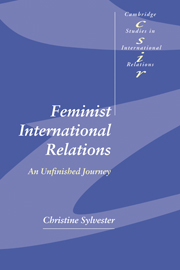Book contents
- Frontmatter
- Contents
- Acknowledgments
- Part I Introduction
- Part II Sightings
- Part III Sitings
- 8 The emperors' theories and transformations: looking at the field through feminist lenses
- 9 Feminists and realists view autonomy and obligation in international relations
- 10 Some dangers in merging feminist and peace projects
- 11 Gendered development imaginaries: shall we dance, Pygmalion?
- 12 Empathetic cooperation: a feminist method for IR
- Part IV Citings
- References
- Index
- CAMBRIDGE STUDIES IN INTERNATIONAL RELATIONS
8 - The emperors' theories and transformations: looking at the field through feminist lenses
Published online by Cambridge University Press: 22 September 2009
- Frontmatter
- Contents
- Acknowledgments
- Part I Introduction
- Part II Sightings
- Part III Sitings
- 8 The emperors' theories and transformations: looking at the field through feminist lenses
- 9 Feminists and realists view autonomy and obligation in international relations
- 10 Some dangers in merging feminist and peace projects
- 11 Gendered development imaginaries: shall we dance, Pygmalion?
- 12 Empathetic cooperation: a feminist method for IR
- Part IV Citings
- References
- Index
- CAMBRIDGE STUDIES IN INTERNATIONAL RELATIONS
Summary
The essays in Part III anchor sightings of women and gender in sites of IR and sites of feminism. The methods for doing so range across the standpoint thinking preferred by Enloe and Tickner, to postmodernism, postcolonialism, art theory, literary theory, and imaginaries of feminist world-traveling – approaches deriving mostly from intellectual developments outside the field of IR. The various siting methods help us match what we see with what we can know about international relations, and what we can be within “it.”
“The Emperors’ Theories” is an early effort (1991) to persuade mainstream IR to site feminist epistemologies on the inside rather than the outside of the field. The late 1980s, when I prepared this piece, were an exciting time in feminist theorizing. Sandra Harding had recently published what would become her classic statement on The Science Question in Feminism (1986), setting out empiricist, standpoint, and postmodernist epistemological choices. Nancy Hartsock (1985) was challenging us to choose a standpoint entry into social inquiry, based on her incorporation of feminism into Marxist political economy; meanwhile, non-Marxist, discourse analytic messages surged through Elshtain's Women and War (1987). These works revealed variety in feminist methods and indicated their overall relevance to fields that did not yet give feminism a passing nod.
Across the feminist methods, one could see the tendency to by-pass or fix up the positivist approaches most US graduate schools routinely taught budding political scientists.
- Type
- Chapter
- Information
- Feminist International RelationsAn Unfinished Journey, pp. 159 - 181Publisher: Cambridge University PressPrint publication year: 2001



